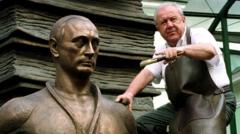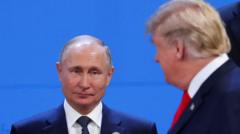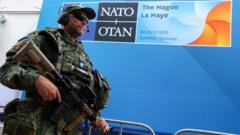Zurab Tsereteli, renowned for his grandiose and often debated monuments, died at the age of 91, marking the end of a prolific career that spanned several decades. Born in Tbilisi, Georgia, the artist rose to prominence during the Soviet era and became known for creating some of the largest sculptures in the world, including a towering monument to Tsar Peter the Great in Moscow that stands at 98 meters (321 feet) tall. Despite his controversial designs that earned him criticism, Tsereteli was equally admired and respected within the art community.
Zurab Tsereteli: A Polarizing Legacy of Monumental Art

Zurab Tsereteli: A Polarizing Legacy of Monumental Art
Georgian-Russian sculptor and painter Zurab Tsereteli has passed away at the age of 91, leaving behind a contentious yet impactful legacy in the art world.
Throughout his career, Tsereteli forged close ties with the Russian political establishment, drawing inspiration from figures like President Vladimir Putin, whom he praised for his "healthy soul." His relationship with the upper echelons of Soviet society afforded him international opportunities, including meetings with notable artists such as Pablo Picasso.
In response to his death, Maria Zakharova, spokesperson for the Russian Foreign Ministry, commemorated Tsereteli's contributions, emphasizing his position as a global artist dedicated to fostering peace and creativity through his works. However, his monumental creations often sparked controversy among the public, receiving mixed reactions; residents of Moscow once expressed their disdain for the Peter the Great monument—a sentiment echoed in various cities where his art was displayed.
Tsereteli's work includes internationally recognized pieces like the "Tear of Grief," which memorializes the victims of the 9/11 attacks in New Jersey, and "Good Defeats Evil," located at the United Nations headquarters, symbolizing the triumph over nuclear warfare. His projects also extended to the construction of fishing vessels, an architectural role in the reconstruction of Moscow's Cathedral of Christ the Saviour, and even smaller bronze sculptures depicting iconic figures such as Princess Diana and leaders from the Yalta Conference.
Notably, many of Tsereteli's grand designs were initially rejected by various cities, prompting the creation of the controversial "Birth of the New World" monument in Puerto Rico instead of more sought-after US locations. The juxtaposition of Tsereteli's towering artistry against the backdrop of public sentiment highlights the duality of his legacy—a towering figure in the art world loved by some and loathed by others.
As Tsereteli’s contributions to contemporary sculpture and architecture linger in the global landscape, discussions regarding his artistic influence and polarizing nature will undoubtedly continue, reflecting the complexities of art's role in society.
In response to his death, Maria Zakharova, spokesperson for the Russian Foreign Ministry, commemorated Tsereteli's contributions, emphasizing his position as a global artist dedicated to fostering peace and creativity through his works. However, his monumental creations often sparked controversy among the public, receiving mixed reactions; residents of Moscow once expressed their disdain for the Peter the Great monument—a sentiment echoed in various cities where his art was displayed.
Tsereteli's work includes internationally recognized pieces like the "Tear of Grief," which memorializes the victims of the 9/11 attacks in New Jersey, and "Good Defeats Evil," located at the United Nations headquarters, symbolizing the triumph over nuclear warfare. His projects also extended to the construction of fishing vessels, an architectural role in the reconstruction of Moscow's Cathedral of Christ the Saviour, and even smaller bronze sculptures depicting iconic figures such as Princess Diana and leaders from the Yalta Conference.
Notably, many of Tsereteli's grand designs were initially rejected by various cities, prompting the creation of the controversial "Birth of the New World" monument in Puerto Rico instead of more sought-after US locations. The juxtaposition of Tsereteli's towering artistry against the backdrop of public sentiment highlights the duality of his legacy—a towering figure in the art world loved by some and loathed by others.
As Tsereteli’s contributions to contemporary sculpture and architecture linger in the global landscape, discussions regarding his artistic influence and polarizing nature will undoubtedly continue, reflecting the complexities of art's role in society.




















